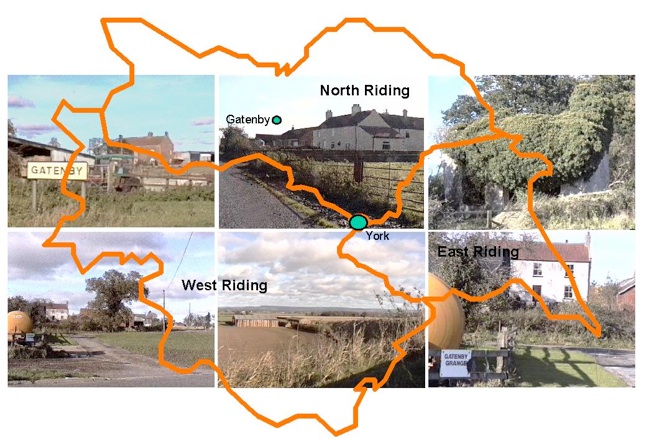Gatenby is located just off the A1 road in North Yorkshire. It is a township in the parish of BURNESTON, wapentake of HALLIKELD, North riding of the county of YORK, 4¾ miles east from Bedale. The village of Gatenby, which consists of no more than a few houses, had a population of 65 in 1811 which had dropped to 34 by 1951. It occupies a rural placement in a largely agricultural environment. Gatenby is mentioned in the Doomsday Book.
Two suggestions have been put forward for the origin of the name. The name Gatenby is believed of Norman origin, ranking amongst the oldest. Gatenby, the place, is mentioned in the Domesday book of 1086 from the lands held by the Count Alan following the Norman conquest of 1066. He held about 350 acres under Robert, one of his loyal followers. Records have shown that the surname Gatenby emerged as a distinguished English family name in the county of Kent where Hamon de Gatton was granted lands in Throwly in Kent about the 12th century. Later the family name moved northward and acquired lands in Yorkshire at Gatonby, or Gatonsby, or Gatenby, all of which have been used. This unique native characteristic of Yorkshire countrymen was to name their estates by adding 'by' to their own name, meaning a village. This is a relic of Viking influence. Most English Gatenby families originated from this area, with many Gatenby families spread within 20 miles radius from here during the 16th to 19th centuries. Alternative spellings are originated from a common root and include Gatton, Gattonsby, Gatensby, Gatonby, Gattenby, and these changes often occurred between father and son. Clerks recorded the name phonetically, as it sounded. Many people were born with one spelling, married with another and buried with another. Sometimes kinsmen and women spelled their names optionally, indicating a different branch of the family, a religious preference, or sometimes to proclaim a national heritage.
The most favoured origin of the name being "Gaithan's By" or "Gaithan's Farm"; Gaithan being an Old Celtic personal name. The other suggestion is that the name derived from the Old Norse "Geita-nes-byr" or "Farm on the Goat's Tongue of Land." Records of the district show that the tenants in Demesne in the early thirteenth century were a family bearing the territorial name of Gatenby. Roger de Gatenby, who died before 1229, had three daughters and co- heiresses, of these Joan (or Juliana) married Robert Maulovel. Later records show that one of the tenants of Gatenby in 1270 was Stephan Maulovel, who was the son of Robert Maulovel and Joan Gatenby. The seat of the Maulovel family was Rampton, Nottinghamshire, but after the time of Stephan, Gatenby was held by a younger branch which called itself Maulovel alias Gatenby. William Gatenby, son of a Thomas Gatenby was holding land there in 1421 and another William in 1523. In 1551, John Gatenby, presumably the son of William, died leaving a son William. William's son Anthony succeeded him. Anthony was living at the time of the Herald's visitation of Yorkshire in 1574, and the arms: ermine, a chevron, gules between three mullets azure are recorded therein. Anthony had four children, but only Mary and Anne survived. Mary married William Bowes and Anne married Thomas Warcop who jointly held the manor of Gatenby. At this point, the name Gatenby seems to have died out; but only the main line of descent has been considered, Anthony Gatenby of the visitation had two brothers. One of them, John, married and may well have had children.
In the arms, the ermine is the usual field derived from the arms of the old Earls of Richmond (their feudal territory was Richmondshire - now called Yorkshire), the mullets and chevron and their colour difference from a large feudally related group of knightly houses." (provided by Rick Gatenby)


